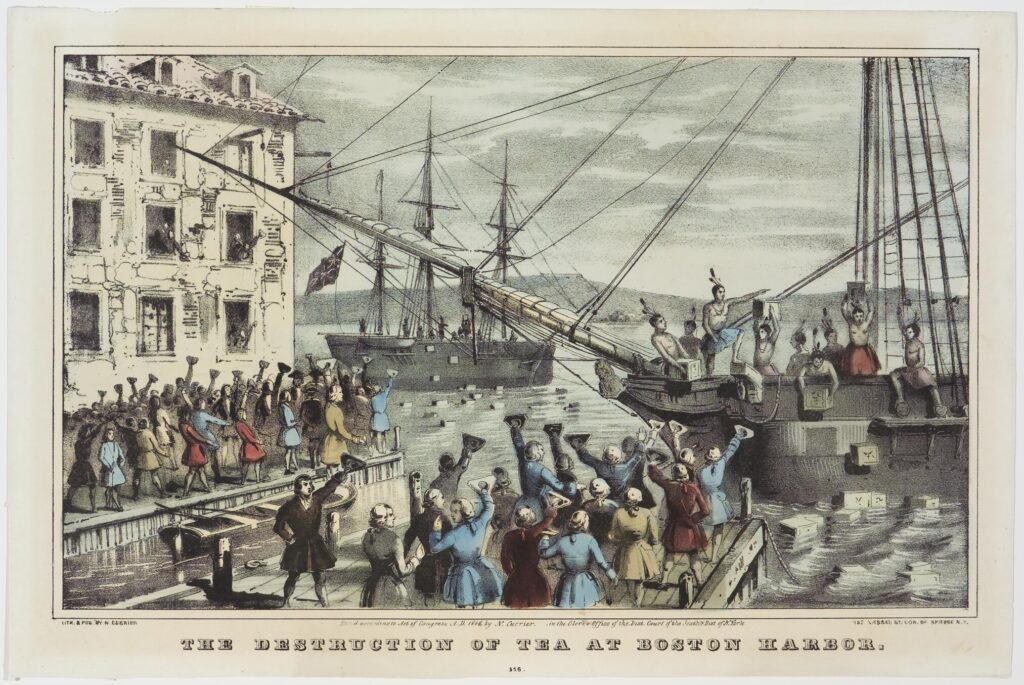
To all Americans, the Boston Tea Party conjures images and stories we’re all familiar with. A bunch of colonists angry about taxes and dressed as Mohawks dumping $1.7 million of tea into Boston Harbor in a dark December night. It upped the ante in America’s War for Independence. It led to thousands of artists’ renditions. But the Boston Tea Party also helped a mood shift in American tavern culture and a change in American drinking habits. And it was planned in a tavern.
In our uber-connected times, I can get up in the morning and call a complete stranger a Nazi before I even get off the toilet. And this is awesome. However, this sort of chummy comraderie wasn’t possible 250 years ago from afar unless you wanted to send a letter and that sort of defeated the purpose of zinging someone. So, people had to meet. Where? The pub. The tavern was the place to be in Colonial America when people lived in a relatively unconnected way or further apart. There weren’t massive offices like there are now. The tavern was the place to meet, drink, eat, engage, read, and socialize in colonial America.
Not only was the tavern where people met and engaged, but it was where the sought and found entertainment. And boy did people in 1770 need entertainment. The lack of Gameboys and basketballs meant that children had to horrifically rely on themselves for entertainment. This led to games such as jumping. Adults at the time were ingenious and found ways to trick kids into doing work by calling it games. This metastasized in quilting bees and wood-carrying contests. When the kids found their way home, the adults had to get away from them and for this they went to the tavern.
Taverns had the benefits of being a. child free and b. full of booze. It also had entertainment, usually dictated by who the tavern catered to. This is because the adults’ station in society usually dictated their hobbies and free time activities. Upper crust men played chess, read books, engaged in political and social debate, and wished for the rest of humanity to disappear off the face of the planet. The lower classes enjoyed simpler games and physical activities like horseback riding and killing native peoples who lived near their house. The colonial tavern provided both. And booze. Lots and lots of booze.
Taverns that catered to elites were filled with books, pamphlets, and broadsheets; intellectually-geared clubs allowed men an opportunity to discuss interesting subjects. Benjamin Franklin had a club at the Green Tavern which demanded each potential member write an essay on a topic of his choice. Long scrolls or tapestries about famous battles or scripture stories were unravelled and lecturers told stories and answered questions. In direct contrast to our current state of informational blitz, the news in the mid-18th century came slowly and when it did people were eager to hear it and talk about it.
But not everyone. For the lower or working classes, taverns had games like whist, backgammon, and checkers. But it was the physical games that here most popular. Shuffleboard, cock fighting, dice, ninepins, and quoits were played. Quoits involved heaving a piece of metal, rope, or a rubber ring to land on a spike. About 150 years later this game was renamed to ‘horseshoes’ to better collocate with ‘hand grenades’ to idiomatically convey the importance of goal fulfillment. Ninepins was the precursor to bowling, no word if you had to rent shoes.
Otherwise, taverns hosted theater and traveling shows. Punch and Judy shows, magicians (who were often considered the lowest form of entertainment), ventriloquists, jugglers, and circus acts drew people to taverns. Though this depended on location as New England had stricter laws regarding drinking, entertainment, or anything that took them away from work and agony. Deformities were a draw (and still are, but they’re on Reddit and not at a tavern). People with three legs, Siamese twins, ‘a cat with eight legs and two tails’ once drew a crowd to the Green Dragon in Boston. And, these being the times they were, African people, Native American chiefs in full war dress, or little people. It must have been an extraordinary experience, made more so by the fact that everyone was drunk on rum. Things must have been good for a while.
But then the 1760s happened and the political climate changed. The Stamp Act brought in more serious times and taverns changed along with them. Instead of enjoying much anticipated news, people became obsessed with Britain, news of taxes, or the colonies’ response. Men were approached aggressively and asked if they were Loyalist or Patriot. The number of pamphlets exploded. The Sons of Liberty took over the Green Dragon as a headquarters. Drinking songs’ lyrics were tweaked or replaced to become political and rebellious. Revolution was in the air and it couldn’t be denied.
The Green Tavern was at the center of these changes and shifts in society. It was where the Sons of Liberty conceived the idea for the Boston Tea Party and a scheme for eavesdropping on British soldiers. The Green Dragon Tavern has been called the ‘Headquarters of the Revolution’ and was central to meetings of the Sons of Liberty, the Freemasons, and much of America’s push for independence. Moreover, the continental congress put limitations on games or ‘wanton entertainment’ that might distract attention away from the all-important task of war with Britain. Taverns took on a more serious, revolutionary atmosphere, a place where secret plots were hatched and unveiled. Two years later, Paul Revere started the most famous run in American history from the Green Dragon Tavern.
We may judge these things with a perspective of Monday morning quarterbacking 2.5 centuries later, but remember that in 2015 Facebook went from a place of sharing cat pictures and memes about bacon to a place to call each other libtards and Nazis. Twitter stopped being a place where people tried to catch the attention of their favorite celebrities and became a place people went for the spectacle of a walking orange dildo. During WWII sauerkraut became liberty cabbage and during Iraq French fries became liberty fries. It should offer some succor to realize that the founding fathers were just as reactionary as we are. That we may roll our eyes at their reactions as well.
So, what to drink?
The Rum Flip.
Ingredients
1 ½ ounces dark rum
½ ounce heavy cream
1 teaspoon granulated sugar
1 fresh egg (whole)
Garnish: grated nutmeg
Instructions
Add all ingredients into a shaker and dry-shake (without ice) like that thing talked about your momma. Add ice and shake again until well-chilled. Strain into a cocktail glass. Garnish with a light dusting of freshly grated nutmeg. Drink to the Boston Tea Party, to the patriots, and to the fact that we have Gameboys and basketballs.
